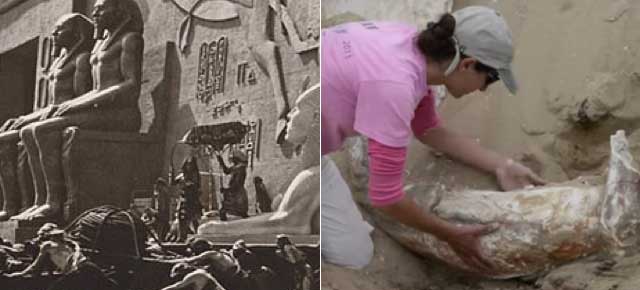Hollywood lore and biblical history have been buried together for almost a century under the coastal sands of California, but archaeologists recently unearthed a massive 4.5m tall Sphinx built for Cecil B. DeMille’s 1923 black-and-white epic The Ten Commandments.
The “Lost City of DeMille” is situated on the Guadalupe-Nipomo Dunes, near San Luis Obispo. Peter Brosnan was one of the first to discover the site in 1983, after DeMille made mention that archaeologists would one day be turning up evidence from the production (not to be confused with the full-colour Charlton Heston classic from 1956 that DeMille also directed). This “clue” led to a deeper investigation; apparently, after filming DeMille was skittish that if anything left behind could enable a quick and easy shoot for rival producers — not to mention he was contracted to properly get rid of of everything he constructed on-site. So the audacious set of biblical proportions — at the time, the biggest ever constructed — was unceremoniously dismantled and buried, as covertly as possible given the massive scale.
In 1990, Brosnan received a $US10,000 grant from Bank of America to help cover equipment costs, including underground radar readings, geophysicist feedback and excavation. In 2012, a Sphinx head was found; this year, they went back for the body. Unfortunately, it had been subsequently exposed and was all but unsalvageable, but the shifting sands of time revealed a different Sphinx — originally, there were 21 in total. So now, discoveries are still being made.
It’s actually miraculous the all the hollow casts hadn’t totally turned to dust themselves in the 91 years since they were unceremoniously abandoned, although they really do look weathered as hell and incredibly crumbly in this video from the Santa Maria Times.
LiveScience explains more about the delicate process:
To keep the paper-thin plaster of Paris from cracking, they wrapped it in cheesecloth soaked in a preservation chemical. Then, they carefully funneled sand out of the hollow statue, replacing the empty space with expanding insulation foam, Hamilton said.
The team could only work a few hours each day. In the morning, the thick, moist fog prevented them from doing their fragile work, and strong winds in the afternoon also stymied their progress. But, after eight days, they finally removed the body and placed it in an off-site building to dry and shrink to its normal size.
It’s also somewhat ironic that the found artifacts are being treated with such reverence, considering they were essentially illicit litter for almost a century.
As early as next year, The Dunes Center in Guadalupe, California, will have the restored Sphinx on display, and according to IMDB, as of May of this year Brosnan was in post-production on a documentary about his efforts, so these new breakthroughs are undoubtedly good publicity. In any event, this may be the latest place to make a celluloid pilgrimage since a renovated Tatooine. [Los Angeles Times; LiveScience]
